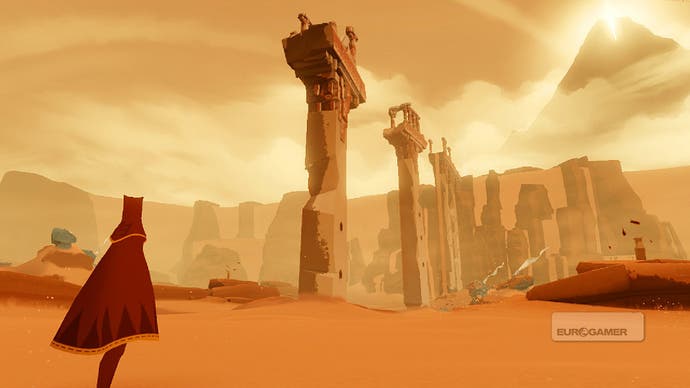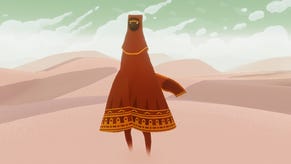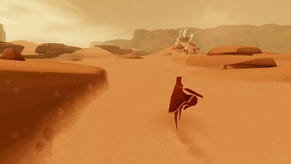Journey
A line in the sand.
There is a game behind these mellow moments, though. Secret runes lengthen your character's poncho-styled cape and add patterns to it. Patches of cloth can be found fluttering in flocks, and can be collected. These then allow you to fly for a short time, although using them sends them flying back to their nesting spot to be reused later.
Flying up ragged banners restores their symbols and in turn affects the gameworld. Chen demonstrates this in an area filled with half-buried ruins and a gigantic derelict bridge. Each banner found and restored helps to fix the bridge, which will lead to a new area. Like everything else in Journey, it's simple and effective.
But there's more to Journey than going walkabout and playing with tapestries. It's a two-player game, of sorts, and it's this area that really seems to inspire Chen. Although you'll be able to share your journey with another player, don't expect the typical co-op play setup.
For one thing, you'll have no choice over the player you're paired with. For another, you won't know anything about them – not even their PlayStation Network ID. And the only way you'll have to communicate will be through a simple sing-song call and a distinctive runic symbol. No voice chat, no lobbies, just the desert.
It all makes Hanicke's impromptu mimes all the more charming, as Chen explains that he wants people to form a connection with another human being, free from assumptions about age, race and gender.

Indeed, one early build of the game had the flight-enabling cloth scraps as a finite resource, but it soon became clear that players were competing to get them first, and to get more than their partner. The idea was duly scrapped, and the more generous recycling method of power-up provision chosen instead.
And that's if you want to work together at all. It's perfectly possible to play through without help, although two players can reach secret areas that remain off limits to solo explorers. Players are placed randomly but if the game detects that one player doesn't want a partner, it simply reshuffles the gameworld and finds a better match.
It's a bold, laissez-faire approach to game design, and one that encourages the player to find purpose and meaning in the experience rather than herding them along. Chen admits that it's made it difficult to fit into the PlayStation's Trophy system, and explains that he wants people to be able to finish the game in a few hours, should they want to.
"Not a second is wasted," Chen insists, and the fact he says this loud enough to actually register on my recorder gives some indication as to how much stock he places in the idea games should only ever be as long as they need to be. The plan is that people will complete it in one immersive sitting rather than dipping in and out.

And with that, it's back to a show floor filled with monsters, bullets and superpowers. It's not hard to stand out among such company, and it's certainly not a slight against the third outings for Killzone, Resistance and Uncharted, all of which look excellent within their own mainstream niche.
But after time spent with thatgamecompany's unique design worldview they also look very obvious and more than a little ordinary. For all its aesthetic ambitions, Journey is clearly not a pretentious experiment. It's a game through and through, based around instinctive notions of play that tap into something quite primal.
What's most notable is that Sony has deemed this quiet, expectation-challenging project worthy of standing alongside their big franchise blockbusters, a draw in its own right rather than an obscure digital sideline.
It's exciting to hear creators like Jenova Chen turning accepted ideas of game design inside out, but it's even more exciting that their approach is no longer consigned to the indie ghetto. The industry landscape is changing, and exploring its expanding frontier looks to be a journey well worth taking.












.png?width=291&height=164&fit=crop&quality=80&format=jpg&auto=webp)



